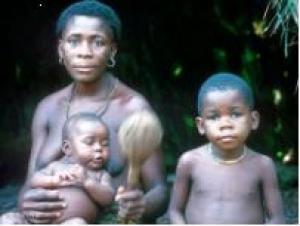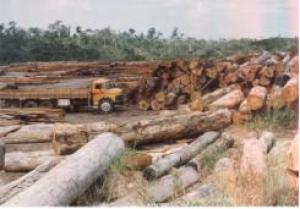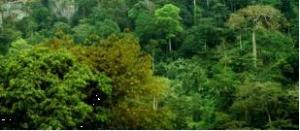Africa has more or less ¾ of the tropical regions of the world. Because of its vegetation, it is an important green ocean, which is to say: the continent consists of forests, woodlands, savannah grasslands and steppes. The tropical forest of Central Africa is the second largest forest complex in the world after the Amazon and is also a major hotspot of biodiversity.
THE RAINFOREST OF CENTRAL AFRICA
PRESENTATION
Africa has more or less ¾ of the tropical regions of the world. Because of its vegetation, it is an important green ocean, which is to say: the continent consists of forests, woodlands, savannah grasslands and steppes. The tropical forest of Central Africa is the second largest forest complex in the world after the Amazon and is also a major hotspot of biodiversity.
This forest is wet; it is one of the most beautiful natural wonders. It has an area of 1,725,000 square km, spread around the following countries:
• Cameroon;
• Gabon;
• Equatorial Guinea;
• Democratic Republic of Congo (R.D.C.);
• Central African Republic;
• Republic of Congo (Brazzaville);
Two-thirds of this forest is found in the Democratic Republic of Congo.
 The rainforest is home to some African tribes, the most famous being: the Pygmies, the Aka, the Baka and the Twa. Overall, these groups have from 130,000 to 170,000 members. These people are smaller in size than the Bantu. Their small stature allows them to move more easily into the forest. They live by hunting, fishing and gathering: the women are gatherers, using baskets on their backs and the men are great hunters. They treat their ailments with medicinal herbs and are able to protect themselves, their animals and the ecosystems of the rainforest.
The rainforest is home to some African tribes, the most famous being: the Pygmies, the Aka, the Baka and the Twa. Overall, these groups have from 130,000 to 170,000 members. These people are smaller in size than the Bantu. Their small stature allows them to move more easily into the forest. They live by hunting, fishing and gathering: the women are gatherers, using baskets on their backs and the men are great hunters. They treat their ailments with medicinal herbs and are able to protect themselves, their animals and the ecosystems of the rainforest.
These groups are generally nomadic, moving into new places in the forest several times a year. Their nomadic lifestyle is less damaging to the rainforest because it allows the group to move without over-exploiting the forest and its resources.
Unfortunately, they do not know what the big companies have in store for them. In exchange for timber worth hundreds of thousands of dollars, logging companies (foreign) provide communities with gifts such as bags of salt and crates of beer, cigarettes, items worth a hundred dollars, and a promise to build them schools and hospitals. These promises are rarely kept, and it has been reported that intimidation tactics are used against those who try to protest.
The Central African forest has a rich biodiversity. It has no fewer than 11 000 plant species, over 400 species of mammals, over 1000 species of birds, nearly 400 reptile species and nearly 200 species of amphibians. Some species of trees are several hundred years old.
In the Democratic Republic of Congo, for example, (according to the permanent service inventory and forest management (SPIAF)) there are 708 tree species identified, grouped into three categories:
Class 1: species exported as logs;
Class 2: species used locally and also exports of logs;
Class 3: unexploited species.
It is an irreplaceable biodiversity and also a major asset for the country and the planet in the fight against climate change.
THREATS TO THE AFRICAN FOREST Everyone knows the important role played by the rainforest in regulating climate. Not only does it protect against the elements but also contributes to the survival of the population. Its existence has always contributed, in its own way, to the ecological balance of the planet.
Everyone knows the important role played by the rainforest in regulating climate. Not only does it protect against the elements but also contributes to the survival of the population. Its existence has always contributed, in its own way, to the ecological balance of the planet.
Indeed, in recent decades, tropical forests are increasingly threatened. In central Africa, illegal logging and felling of trees is rife: some rare trees are exported worldwide to the benefit of industries in developed countries. Deforestation due to overexploitation of the forest occurs; several locations are cultivated in the same season for business reasons and for consumption. Trade in agricultural products and game meat has increased beyond sustainable levels in recent years to meet the growing demand of village populations that are expanding. The intensive use of charcoal and sticks (for building houses) depletes the forest.
In some places where the forest has been cut it can no longer maintain the soil and often causes erosion. This deforestation is also the leading cause of emissions of greenhouse gases globally.
RESULT
All this gives rise to ecological, social and economic challenges: global warming and the disruption of the season, brutal civil war, many tribal conflicts, the race for control of natural resources which have already cost the lives of three and a half million people . Many species are disappearing. Hunters must walk farther and farther in search of porcupines, monkeys and birds used in the local cuisine. Fish is scarce. Even the plump caterpillars of the forest, the main source of protein, are disappearing.
ACTION TAKEN
To address these threats, the Pygmies and the Bantu of the second forest in the world are becoming aware of such destruction and are mapping their natural heritage. They hope to prevent companies from plundering their resources and warming the planet a little more.
To this end, the population is made aware of efforts for re-afforestation. Over 160 villages in the Democratic Republic of Congo, with support from local activists and financial support from international NGOs such as the Rainforest Foundation, have embarked on a programme to map their traditional forest lands. Similar projects are being developed in the neighbouring countries of the Congo Basin. The objective is to the financing that developed countries have agreed to provide the protection of the rainforest. (Copenhagen Summit last December).
In the Bandundu province where the Sisters of the Holy Family are located, we are up against these difficulties. We try to make people aware that we have respect for nature, planting and set an example by replanting and caring for fruit trees, the technique of leaving the land fallow, gardening in plots for the green vegetables. In some places, we encourage those who undertake to build their houses with mud bricks to avoid deforestation. But there are many people who do not yet grasp the merits of this.
The African jungle should not be regarded merely as raw material in the same way that some mineral wealth is, but also, and above all, as a living environment for the global population. Listen

